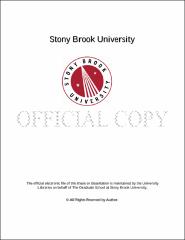| dc.identifier.uri | http://hdl.handle.net/11401/76994 | |
| dc.description.sponsorship | This work is sponsored by the Stony Brook University Graduate School in compliance with the requirements for completion of degree. | en_US |
| dc.format | Monograph | |
| dc.format.medium | Electronic Resource | en_US |
| dc.language.iso | en_US | |
| dc.publisher | The Graduate School, Stony Brook University: Stony Brook, NY. | |
| dc.type | Dissertation | |
| dcterms.abstract | Quantitative ultrasound (QUS) has been accepted widely as a non-invasive, economic, non-radioactive and portable modality for assessing bone heath status. This technology utilizes the basic physical mechanism of interaction between ultrasound wave and bone structure to provide mechanical and structural information of bone. Instead of only evaluating the quantity of bone like other traditional techniques such as duel energy X-ray absorptiometry (DXA), QUS is also capable of measuring the quality of bone such as anisotropy, microarchitecture and microfracture. This advantage of QUS is beneficial for treating the patient suffering from osteoporosis or other bone health deterioration, long term bed-rest patient and astronaut experiences low gravity environment. To improve the current QUS technology for bone mechanical properties assessment and fracture risk prediction, the focuses of this study are: 1) to develop a novel QUS measurement protocol to predict the principal structural orientation (PSO) of spherical trabecular bone model; 2) to use finite element analysis (FEA) to evaluate the mechanical properties in the PSO predicted by QUS; 3) to apply this novel QUS measurement on human calcaneus as an improved evaluation for the mechanical properties. It is shown that the PSO predicted by QUS is highly close to the PSO predicted by micro computed tomography (µCT), and the average angle difference is less than 5° using prediction of ultrasound velocity. The FEA simulation based on the µCT images showed the mechanical strength in the PSO predicted by QUS is significantly higher than the anatomical orientations and highly close to the value in longest vector of MIL tensor measured by µCT. By applying the same QUS measurement of PSO on bovine cubic bone samples and human calcaneus, the correlations between the QUS parameters and the mechanical and structural properties of trabecular bone were significantly improved (p<0.05), suggesting that such QUS measurement can be applied to human calcaneus evaluation and improves the reliability and accuracy for bone strength measurement and fracture risk assessment. | |
| dcterms.abstract | Quantitative ultrasound (QUS) has been accepted widely as a non-invasive, economic, non-radioactive and portable modality for assessing bone heath status. This technology utilizes the basic physical mechanism of interaction between ultrasound wave and bone structure to provide mechanical and structural information of bone. Instead of only evaluating the quantity of bone like other traditional techniques such as duel energy X-ray absorptiometry (DXA), QUS is also capable of measuring the quality of bone such as anisotropy, microarchitecture and microfracture. This advantage of QUS is beneficial for treating the patient suffering from osteoporosis or other bone health deterioration, long term bed-rest patient and astronaut experiences low gravity environment. To improve the current QUS technology for bone mechanical properties assessment and fracture risk prediction, the focuses of this study are: 1) to develop a novel QUS measurement protocol to predict the principal structural orientation (PSO) of spherical trabecular bone model; 2) to use finite element analysis (FEA) to evaluate the mechanical properties in the PSO predicted by QUS; 3) to apply this novel QUS measurement on human calcaneus as an improved evaluation for the mechanical properties. It is shown that the PSO predicted by QUS is highly close to the PSO predicted by micro computed tomography (µCT), and the average angle difference is less than 5° using prediction of ultrasound velocity. The FEA simulation based on the µCT images showed the mechanical strength in the PSO predicted by QUS is significantly higher than the anatomical orientations and highly close to the value in longest vector of MIL tensor measured by µCT. By applying the same QUS measurement of PSO on bovine cubic bone samples and human calcaneus, the correlations between the QUS parameters and the mechanical and structural properties of trabecular bone were significantly improved (p<0.05), suggesting that such QUS measurement can be applied to human calcaneus evaluation and improves the reliability and accuracy for bone strength measurement and fracture risk assessment. | |
| dcterms.available | 2017-09-20T16:51:37Z | |
| dcterms.contributor | Qin, Yi-Xian | en_US |
| dcterms.contributor | Dilmanian, F. Avraham | en_US |
| dcterms.contributor | Lin, Wei | en_US |
| dcterms.contributor | Li, Baosheng | en_US |
| dcterms.contributor | Kaufman, Jonathan. | en_US |
| dcterms.creator | Lin, Liangjun | |
| dcterms.dateAccepted | 2017-09-20T16:51:37Z | |
| dcterms.dateSubmitted | 2017-09-20T16:51:37Z | |
| dcterms.description | Department of Biomedical Engineering. | en_US |
| dcterms.extent | 129 pg. | en_US |
| dcterms.format | Application/PDF | en_US |
| dcterms.format | Monograph | |
| dcterms.identifier | http://hdl.handle.net/11401/76994 | |
| dcterms.issued | 2014-12-01 | |
| dcterms.language | en_US | |
| dcterms.provenance | Made available in DSpace on 2017-09-20T16:51:37Z (GMT). No. of bitstreams: 1
Lin_grad.sunysb_0771E_12018.pdf: 1724339 bytes, checksum: be365ecde4c858b0f24cfaaa53cfdb8a (MD5)
Previous issue date: 1 | en |
| dcterms.publisher | The Graduate School, Stony Brook University: Stony Brook, NY. | |
| dcterms.subject | biomechanics, medical ultrasound imaging, osteoporosis, trabecular bone | |
| dcterms.subject | Biomedical engineering | |
| dcterms.title | Analysis of Principal Structural Orientation of Trabecular Bone Using Quantitative Ultrasound | |
| dcterms.type | Dissertation | |

